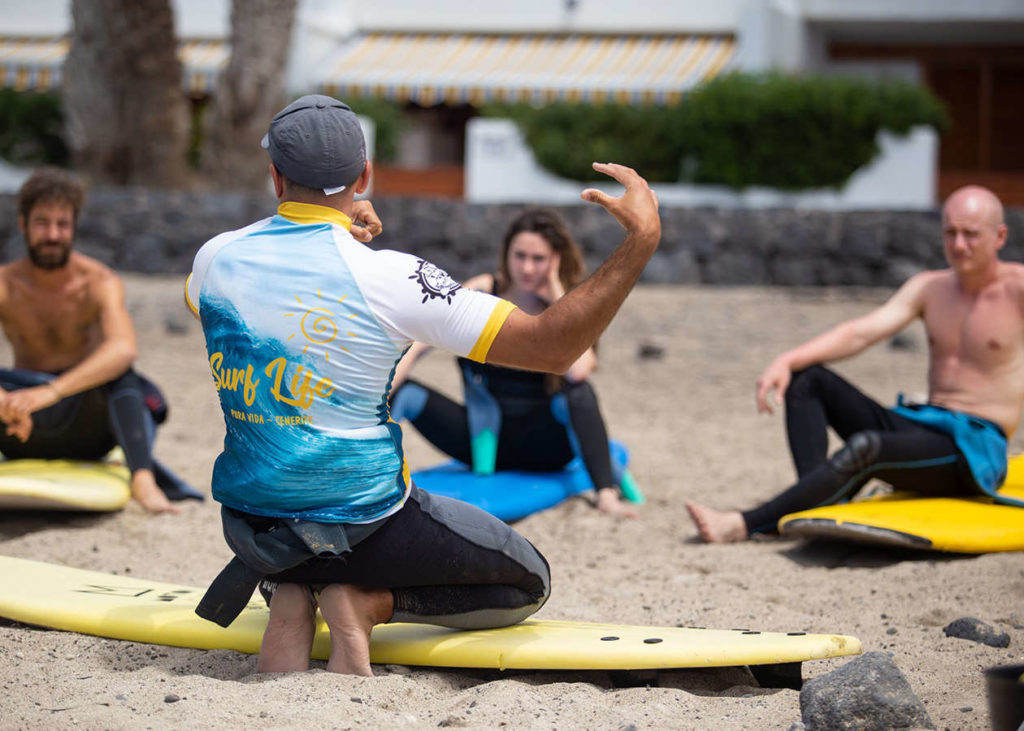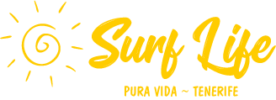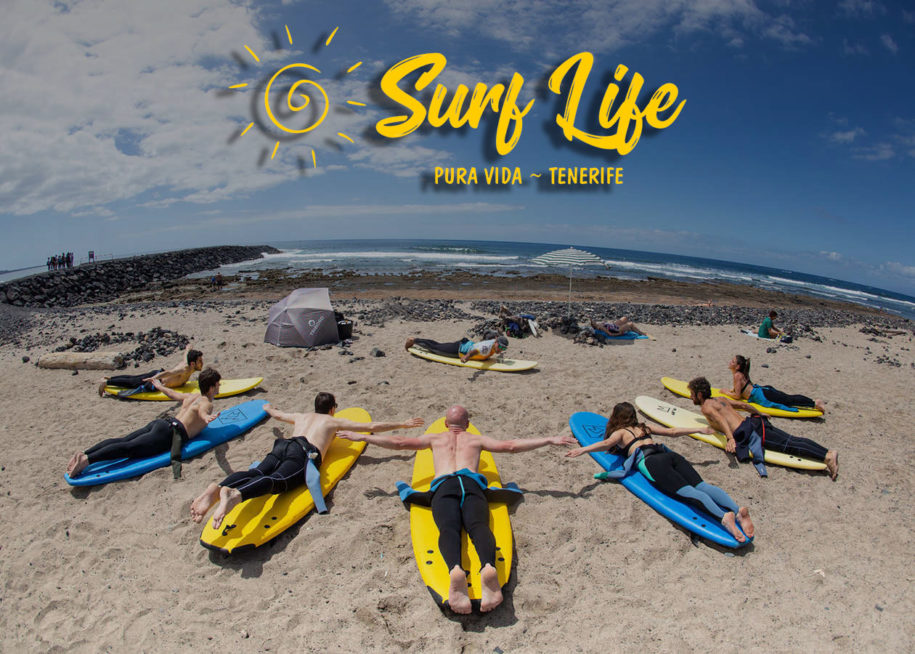Surfing for beginner
Surfing for beginners is an activity that must be guided in every aspect considering the numerous factors that shape a wave like the tides, currents, winds and many more of elements that might suddenly change the surf conditions while you don’t realise it immediately. As a beginner surfer who would like to improve, a unique solution is a surf camp vacation with other travelers coming from different countries, with a good beginner surf school providing transfers to the beach and a safe practice into the water. That’s definitely the best way to discover the good vibes that surround this sport.
As discussed in the previous articles, the island of Tenerife defines itself as a really good destination for a beginner surfer. In the South West, Playa de Las Américas is a good base to start your experience in a beginner surf school in Tenerife. With few little surfing tips, you might be able to start your lessons in a proper way, and guess what: we’re here to help you!
Choose the right surf spot
If you are a beginner surfer, the best advice we can give you is always to get in the water accompanied by a surf school instructor! Of course, surfing in a sandy beach might be the perfect easy start, but also a rocky point will ensure loads of fun, always keeping an eye on the tide level! Stay safe and out of the peak, where surfers with more experience have their right to enjoy, and never surf alone where you’ve never surfed before!

Credit Pablo Borboroglu photography
Choose the right beginner surfboard
Yes, we know: a short board looks really attractive. Did you see the latest surf competition? Those pros are really shredding out there, with their fast maneuvers and aerials! It looks so easy, doesn’t it? We don’t want to destroy your dreams, but as a beginner surfer we advise you to GO BIG! Big waves? Definitely not. Big boards! The best way to start your surf experience is a with a 8 ft soft-top. This kind of boards might look pretty huge at the beginning and usually, people are afraid of not being able to control them. The truth is that the big volume will really forgive the basic common stand up mistakes, which will allow you to perfection your technique while keeping on having lots of fun. This kind of boards are covered with a soft material which is also a really good advantage in terms of safety. Every good beginner surf school has a wide range of beginners surfboards from 7ft to 9ft. And the most important factor: they need to be pretty wide. The wider and the longer the board is, the higher the volume. This will definitely help you at the beginning.
During the intermediate and beginners surf lessons with Surf Life Tenerife, we can count on a wide range of 25 surfboards, starting from 6ft soft or hard top (made with epoxy resin) to 8ft and 9ft hard-board or soft-top. In the following video you can check out which are the types of intermediate and beginner surfboards you can use with us.
Our team of surf instructors strongly recommend don’t skip intermediate steps when you try a new board. Before going shorter than a 8ft, refine your technique and try to push your limit with what you have. When you are ready to switch the board, a 7ft softboard will be a good intermediate step before trying a similar length hard board or a shorter soft-top.
Don’t hesitate to contact me and my team for more info about beginner surfing sizes.
Beginner surfing tips
Like in every sport, haste makes waste. Above all, for surfing, it is really important to find a beginner surf school with professional licensed instructors who are able to separate all the small steps that contributes to a good learning of the surfing process. Rushing into your learning and getting into the water before a proper technique lesson at the beach will probably take you to jump on the board without having found stability while laying on it. During our intermediate and beginner surf camp in Tenerife, you will be invited to focus, steps by steps, on every little move and pose necessary to approach surfing in a complete way:
- Find your stance: every beginner surfer has a favourite stance. When you stand in a asymmetrical position with your right foot on the back and your left foot in the front, your stance is called regular. If you find your balance in the opposite way and you feel more natural with your left foot on the back, then your stance is called goofy. There is not a right stance, it just depends on what you prefer the most!
Watch our video and find out how to discover if you are regular or goofy.
- Learn how to lay and paddle on the board: one of the most common mistakes that you may notice during a beginner surf lesson is the nosedive. This happens, when we lay to much towards the front of the board and therefore push the nose (top of the board) underwater. Pretty funny to see sometimes, but not so pleasant! In order to avoid that the nose goes underwater with an 8/9 ft beginner surfboard, we need to keep our feet closed to the tail and lift our chest and head up while we paddle.
- Stand up on the board: do you remember the pros we were speaking about at the beginning of the article? Yes, those who were flying in the air with their surfboards! Have you ever noticed how they take off on the board? Yes, we know. It looks like a jump. But it’s not. When it comes to standing up on the board, the most common mistake is to rush upwards and make a big jump. Remember: haste makes waste! If you jump with both of your feet at the same time, no part of your body will be in control with the board. You might land with your feet in the right position, or maybe not. A good standing up always ensures the board is always under control. So we can:
- Stand up with our back foot and front foot: this is the proper way of standing. First we put our back foot 90° degrees in the middle of the tail – right in the middle of the fins – and then looking forward, we put the front foot around 45° in the middle of the surfboard.
- Stand up with your back knee: if it does not work in the first way we can than try to add one more step, instead of the back foot, we will put first the back knee in the middle of the board, and then the right foot in front. You’ll see that, with a quick pop up, we will be able to stand up easily.
Check out our video, everything will be clear!
- Get your balance and direction on the wave: once you stand, the fun part starts. Use your arms to find the balance! It is important that your body looks forward. If you keep the right arm in front of you and you keep pointing and looking at the direction you want to go to, you will go there. At the same time, the position of the other arm will ensure your balance. Don’t let it too much in the back or too close to the body, otherwise you will fall on the side.
My advices in the video, click play
Our school is composed of professional licensed surf instructors specialised in intermediate and beginner surf lessons. We offer surf lessons for private students and in groups of maximum 6 persons per instructor, as we want our students to live a tailored-made surf experience. You can book your intermediate and beginner surf camp in Tenerife with us through our CONTACT FORM. On our surf school page you can find all the different surf lessons we offer and choose the one which most fits you.
You can find our Surfing Pills here – Youtube playlist
Subscribe to our Youtube channel and you’ll be updated with new upcoming videos.
Antonio
Founder and surf instructor of Surf Life Tenerife


One Comment
ปั้มไลค์
Like!! Great article post.Really thank you! Really Cool.